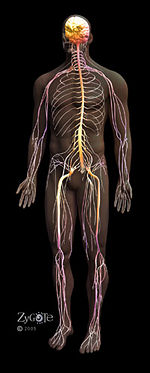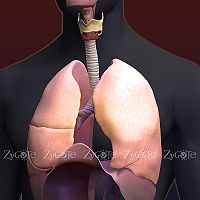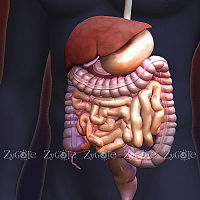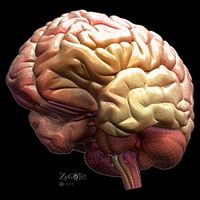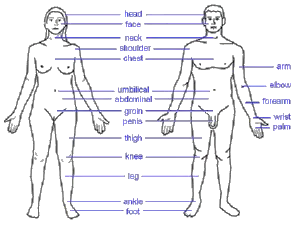Human body
As commonly defined, the human body is the physical matter of a human being, including the chemical elements, cells, and extracellular materials and the organization of these materials into tissues, organs, and systems. The human body, like the bodies of all animals, is made up of systems, that are made up of organs, that are made up of tissues, that are made up of cells.
Several fields are involved in the study of the human body. Human anatomy or anthropotomy is a specialized field within anatomy that is focused on the structure and form of the human body, such as the description of organs and organ systems Human physiology is a specialized field within physiology that encompasses the study of the functioning of the human body, including systems, tissues, and cells. Thus, physiology tends to be more dynamic, and concerned with functioning, while anatomy is more descriptive of structure. The study of tissues is the focus of histology and the study of cells is part of cytology.
Since human beings define themselves not just in biological terms, but also in social, spiritual, and religous terms, it is natural that the term "human body" can take on broader meanings than defined above. In some religions, for example, there is a concept that humans have not only a physical body, but also a "spiritual body," which may mirror the appearance of the physical body, but that also exists after the death of the physical body. An example of such is found in the Bible: "??? spiritual body".
In addition, the concept of human body is often used in context of "mind-body unity" or "mind-body" disunity, in order to convey a separation between physical and spiritual desires, or as reflected in philosophy, the "mind-body problem."
(look up the ICUS book on mind/brain, etc.)
See History of anatomy for a history of anatomy, including human anatomy.
Major systems of the human body
- Cardiovascular system: blood circulations with heart and blood vessels
- Digestive system: processing food with mouth, stomach and intestines
- Endocrine system: communicating within the body using hormones
- Excretory system: eliminating wastes from the body
- Immune system: defending against disease-causing agents
- Integumentary system: skin, hair and nails
- Muscular system: moving the body
- Nervous system: collecting, transferring and processing information with brain and nerves
- Reproductive system: the sex organs
- Respiratory system: the organs used for breathing, the lungs
- Skeletal system: structural support and protection through bones.
External features
Common names of well known parts of the human body, from top to bottom :
- Skin
- Head — Forehead — Eye — Ear — Nose — Mouth — Tongue — Teeth — Jaw — Face — Cheek — Chin
- Neck — Throat — Adam's apple — Shoulders
- Arm — Elbow — Wrist — Hand — Fingers — Thumb
- Spine — Chest — Breast — Ribcage
- Abdomen — Belly button — Sex organs (Penis/Scrotum or Clitoris/Vagina) — Rectum — Anus
- Hip — Buttocks — Leg — Thigh — Knee — Calf — Heel — Ankle — Foot — Toes
Internal organs
Common names of internal organs (in alphabetical order) :
- Adrenal glands — Appendix — Bladder — Brain — Duodenum — Gall bladder — Heart — Intestines — Kidney —Liver— Lungs — Ovaries — Pancreas — Parathyroid gland — Pituitary gland — Prostate gland — Spleen — Stomach — Thymus gland — Thyroid gland — Testicles — Womb
Anatomy of the brain
- Amygdala — Brainstem — Cerebellum — Cerebral cortex — Hypothalamus — Limbic system — medulla— midbrain — Pituitary gland — pons
- See also: Human brain, List of regions in the human brain
Studying human anatomy
Certain professions, especially medicine and physiotherapy, require the study of human anatomy in depth. Textbooks usually split the body into the following regional groups:
- Head and Neck - includes everything above the thoracic inlet
- Upper limb - includes everything from your hand, forearm, arm, shoulder, axilla, pectoral region and scapular region.
- Thorax - contains the region of the chest from the thoracic inlet to the thoracic diaphragm.
- Abdomen - everything from the thoracic diaphragm to the pelvic brim or to the pelvic inlet.
- The back - about the spine and its components, the intervetebral disks and bodies
- Pelvis and Perineum - the pelvis consists of everything from the pelvic inlet to the pelvic diaphragm. The perineum is everything below the pelvic diaphragm.
- Lower limb - the lower limb is usually everything below the inguinal ligament, including the thigh, the hip joint, the leg, and the foot.
See also
- Anatomy
- Body orifices
- Death - physical consequences of death
- Human
- Human biology
- Terms for anatomical location
- List of human anatomical features
- List of human anatomical parts named after people
- List of regions in the human brain
- List of bones of the human skeleton
- List of muscles of the human body
- List of distinct cell types in the adult human body
an:Anatomía umana zh-min-nan:Sin-khu de:Anatomie des Menschen et:Inimese anatoomia es:Anatomía humana eo:Homa anatomio fa:کالبدشناسی انسان fr:Anatomie humaine it:Anatomia umana he:גוף האדם hu:Emberi test nl:Menselijke anatomie ja:人体解剖学 no:Menneskets anatomi pl:Anatomia człowieka pt:Corpo humano sk:Anatómia človeka sl:Anatomija človeka uk:Анатомія людини zh:人体
Credits
New World Encyclopedia writers and editors rewrote and completed the Wikipedia article in accordance with New World Encyclopedia standards. This article abides by terms of the Creative Commons CC-by-sa 3.0 License (CC-by-sa), which may be used and disseminated with proper attribution. Credit is due under the terms of this license that can reference both the New World Encyclopedia contributors and the selfless volunteer contributors of the Wikimedia Foundation. To cite this article click here for a list of acceptable citing formats.The history of earlier contributions by wikipedians is accessible to researchers here:
The history of this article since it was imported to New World Encyclopedia:
Note: Some restrictions may apply to use of individual images which are separately licensed.
